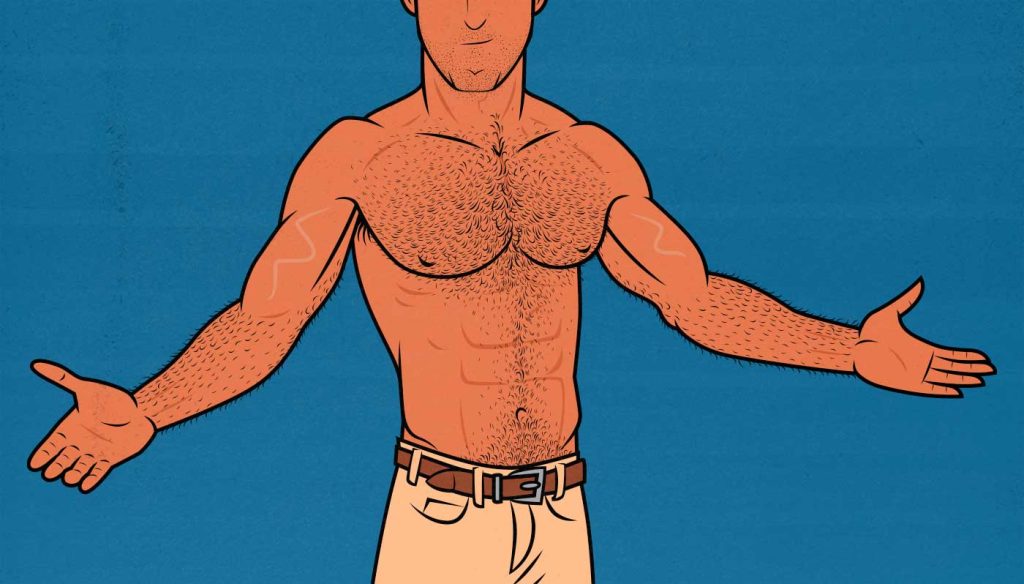
The Skinny Guy’s Guide to Building a Hollywood Physique
In this article, I want to talk about realistic physique goals, both in terms of understanding the timeframe that it takes to build muscle, as well as how good you can expect to look by the end of it. Perhaps it’s our audience, being largely made up of skinny guys who actively seek out information, but we tend to see things differently than a lot of other fitness professionals.
Can you look like the sex icon from the latest Hollywood movie? Well, you can’t transform your face, and building muscle won’t automatically make you more charismatic, but can you have physique of Brad Pitt from Fight Club, Christian Bale in American Psycho, Will Smith in I Am Legend, Gerard Butler in 300, or Daniel Craig in James Bond? Yes, you probably can.
None of those actors have great muscle-building genetics. All of them are naturally skinny—so-called ectomorphs. Some of them are naturally lean, yes, but so are many of us. And believe it or not, most of them didn’t even routinely lift weights until a few months before shooting for those films. These aren’t just realistic physiques, these are physiques you can probably build with just a few months of dedicated weight training.
I realize this might sound crazy, but hear me out.

Actors Often Have Realistic Physiques
A lot of people think that celebrities have exceptional physiques, creating unrealistic expectations for how lean and muscular we can expect to become. In some cases, that’s true. Good luck looking like Arnold Schwarzenegger, a professional bodybuilder, the Rock, a professional wrestler, or Terry Crews, a football player. Some actors just so happen to have good genetics, too, like Jason Mamoa having muscle before he even touched a weight. But these are the exceptions, not the norm.
The more famous sex-icon physiques are usually well within our genetic potential, especially for us naturally skinny guys. Here’s why:
- Actors rarely become famous because of their muscle-building genetics, they rise to the top because they have handsome faces, charisma, and they’re good actors. As a result, we see a wide array of muscle-building genetics on display. (Arnold Schwarzenegger is an obvious exception.)
- A lot of sex icons seem to be naturally skinny, ranging from Ryan Gosling to Brad Pitt to Christian Bale to Will Smith. I’m not sure why that is, but if we look at the first roles that these actors starred in, most of them are quite thin. (Chris Pratt is a notable exception, being overweight before getting in shape.)
- Most actors aren’t powerlifters or bodybuilders, and many of them don’t habitually lift weights. If we look at interviews with guys like Daniel Craig, he only started training for his role as James Bond six months before they started shooting. And only the last three months were spent lifting weights. (
What we see in movies, then, is what a naturally skinny guy can accomplish with a few months spent with a barbell. And these guys aren’t genetically gifted, either. In fact, some actors who are famous for their physiques have poor muscle-building genetics. Some, like Daniel Craig, Jason Mamoa, and Ryan Reynolds seem to have good genetics, but that’s not the case with Christian Bale, Ryan Gosling, Brad Pitt, Tom Hardy, or Will Smith—they were just regular skinny dudes.
Now, you might argue that these guys have personal trainers and chefs, and that’s true. But have you ever seen the workouts they do to prepare for their roles? Most of them are pretty bad! There’s no reason you can’t do a workout routine that’s much better than theirs. The same with their diets. A lot of them do that whole thing of combining intermittent fasting with low-carb diets, which is trendy but ineffective. You can eat a much better muscle-building diet than them.

Where actors do have a real advantage is with their motivation. They have huge financial incentives to get into shape, a ton of social pressure knowing they’ll be on screen, and personal trainers to push them in the gym. I think that does a great deal to explain why they’re so famous for their body transformation. Because they actually train consistently and hard, and they combine it with a good diet.
Let’s go over a few examples. It’s impossible to say if these actors are lifetime naturals, but I’ve intentionally chosen ones that seem to be natural, with physiques that a natural could realistically build.
Brad Pitt in Fight Club
One of the most famous physiques, at least for those of us around my age—32—is Brad Pitt’s body in Fight Club. In fact, a few years ago we surveyed a few hundred women, showing them a bunch of bodies and asking them to rate how attractive they were. Of all the bodies we showed them, including a bunch of athletes, fitness models, and bodybuilders, Brad Pitt’s physique wound up being rated as the most attractive. So even now, even as its fame fades, women still love this look.
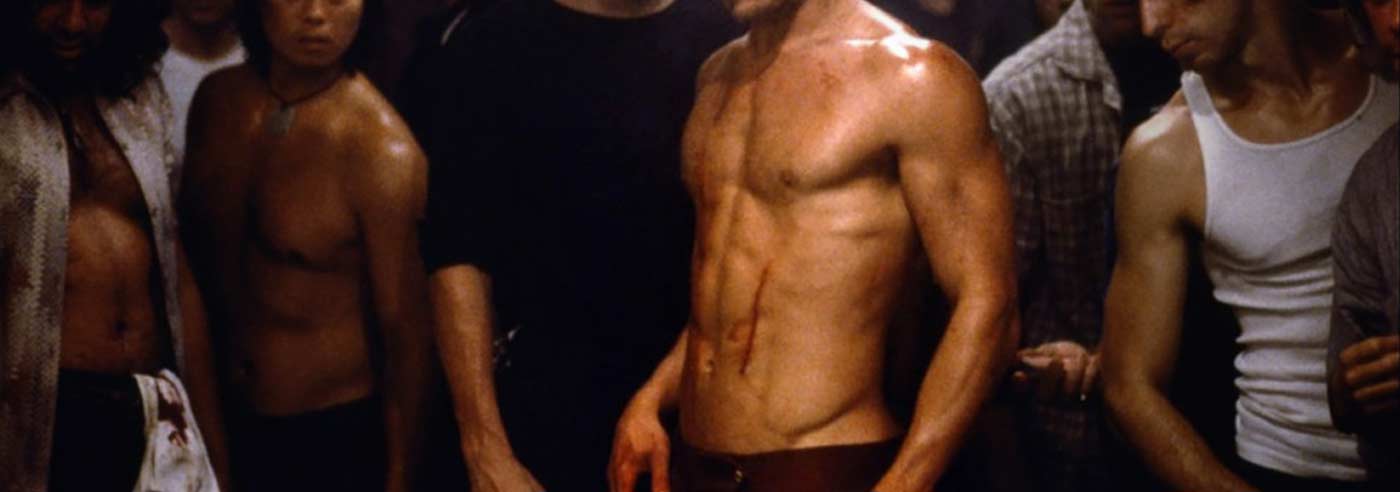
What’s neat about this physique is that most people in the fitness industry scoff at it, saying he only weights like 155 pounds here. Yeah, he’s lean, they say, but he isn’t very muscular. What’s interesting, though, is that when you ask the general public, many of them think that this physique is unrealistic for the average person.
Both sides have a point. Brad Pitt is very lean here. He’s around 10% body fat. Most people can do diet down that low if they have enough dedication, but depending on their genetics, it might be very unpleasant to stay there. Us naturally skinny guys often have a genetic advantage there, finding it easier to maintain leaner body-fat percentages. But even so, not all of us would enjoy being that lean year-round. Maintaining an excessively lean body-fat percentage reduces our testosterone, causes tons of cravings, reduces our energy levels, and makes us weaker. For some of us, it’s better to stay above 8%, for others, 12%, and for others, 15%. But like I said, most of us naturally skinny guys have a genetic advantage here. For instance, I feel my best at 11%.
Now, on the other side of things, Brad Pitt isn’t all that muscular here. If I had to guess, he might have 13–14″ arms, might be benching less than 225 for a single. He’s not super big or strong. And his arms and chest are his two best muscle groups. Even the very skinniest of us can build a comparable amount of muscle within a fairly short time frame. For example, here’s a member of our Bony to Beastly Program:

What’s cool about Brad Pitt’s physique, though, is that he has that great combination of a great chest, good shoulders, good traps, and well-developed arms. What takes it to the next level is that his neck is also fairly muscular, which can be easily accomplished with a few months of neck training.
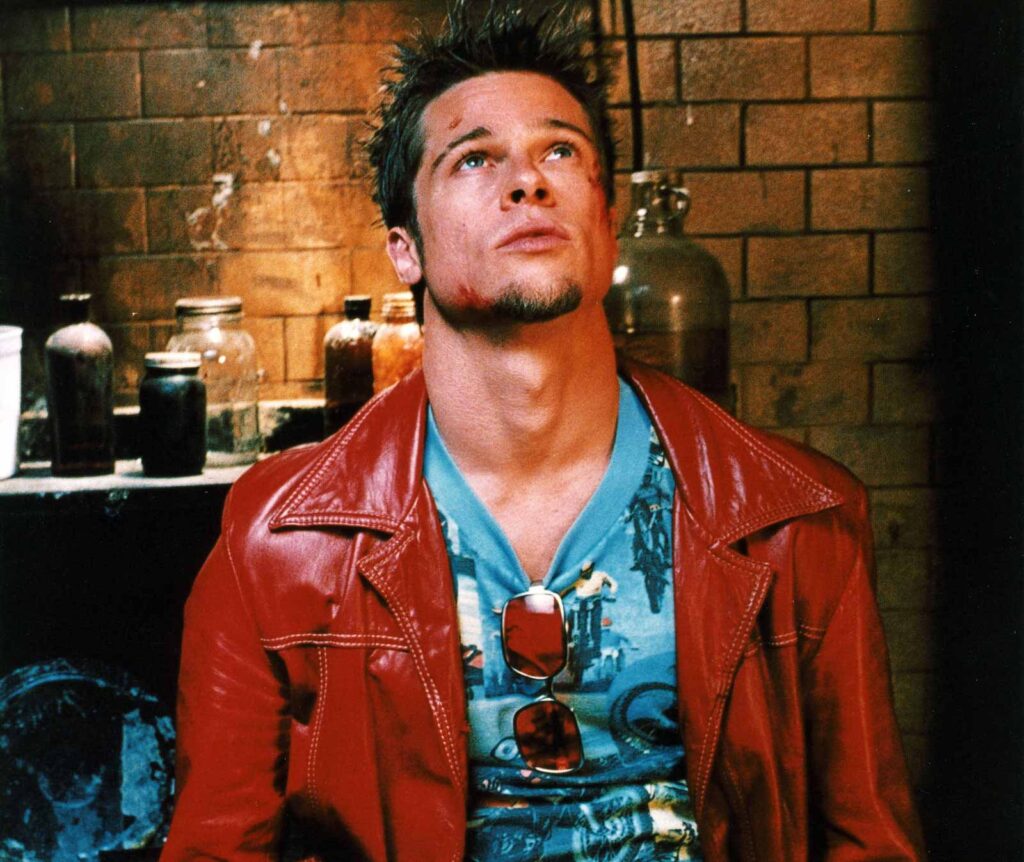
I don’t think his neck is actually all that big. In most scenes it seems to be a fairly normal size, neither skinny nor muscular. But in some of his more iconic photos, he’s flexing his neck, as shown above. You can see that his sternocleidomastoid is well-developed, and when he flexes it, it exaggerates how muscular his neck is, making him look like a fighter. After all, it’s the boxers, wrestlers, MMA fighters, and football players who bulk up their necks so that they can better resist knockouts and concussions. I think that’s a big part of why this physique looks so formidable, why it became so famous.

If we compare Brad Pitt, the sex icon, to Edward Norton, the out-of-shape desk worker, the differences aren’t that dramatic. Both seem to have naturally thinner, ectomorph body types. It’s just that Brad Pitt is a little bit leaner, has a little bit more muscle mass. But what makes the difference seem so stark is that Brad Pitt has noticeably bigger traps, shoulders, and arms. That’s what gives him his iconic shape.
So to build a physique like this, you’d want to focus on getting stronger at a few key lifts:
- The bench press to build a bigger chest.
- The overhead press to build broader shoulders.
- The deadlift, Romanian deadlift, or shrug to build bigger traps.
- Chin-ups and biceps curls to build bigger biceps.
- Neck curls and extensions to build a thicker neck.
- Skullcrushers to build bigger triceps.
That isn’t to say that you should only do those lifts. I’d still recommend squatting and rowing. But if you focus on getting stronger at those lifts for sets of 8–15 reps, you should be able to develop those same muscles that gave Brad Pitt’s physique its distinctive look.
Now, just to be totally clear, Brad Pitt doesn’t have great arm genetics, but he does have fairly long clavicles and good chest genetics. Not everyone’s chest or shoulders will look that broad, even if they build a comparable amount of muscle. But you’ll still look similarly good, just different. Less like him, more like you.
Christian Bale in American Psycho
Christian Bale is a master of physique transformations, having gone from thin to muscular for American Psycho, then becoming underweight for his role in the Machinist, then bulking up for his role in Batman, and then becoming fat for Vice.
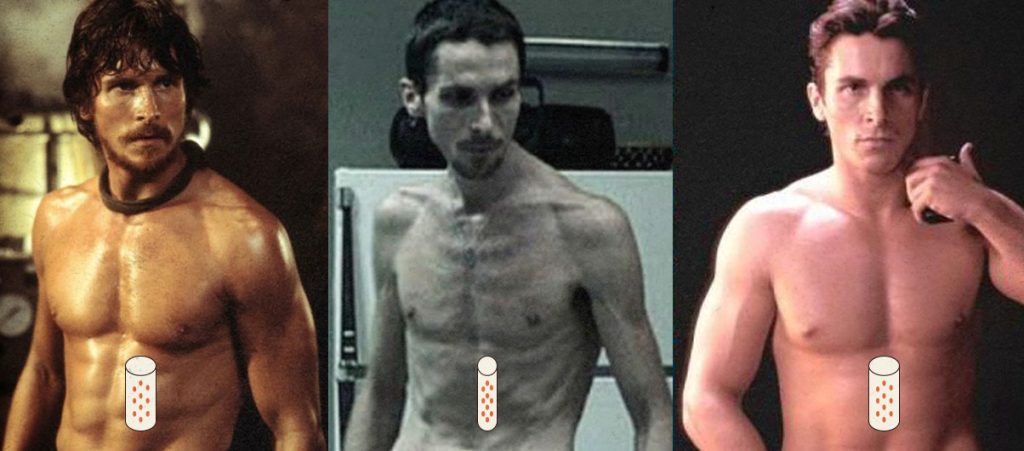
Christian Bale is most famous for gaining over a hundred pounds for his role in Batman, but what a lot of people don’t realize is that he was already comparably muscular in American Psycho. When he bulked up to become Batman, he was just regaining the muscle he’d already gained. It was muscle memory.
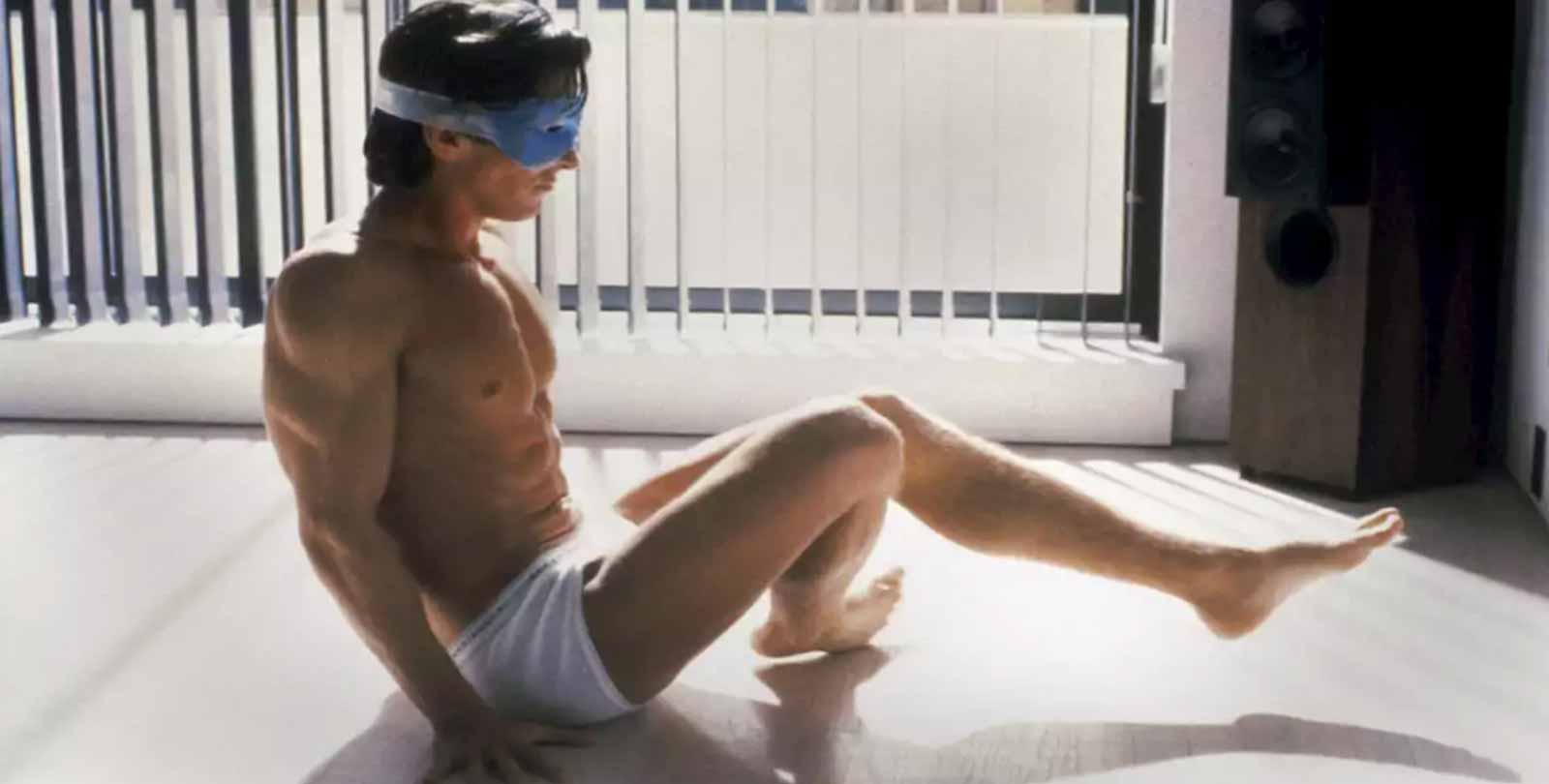
The famous photo of his body in American Psycho is this one here, where he’s doing exercise on the floor in his apartment. He’s got a good chest, big arms and shoulders, and fairly small legs. Not that his legs are tiny or anything, but it looks like most of his effort went into bulking up his upper body. The other thing to note is that it looks like his arms are pumped up for this dramatic shot. If we look at him at other points in the movie, they’re quite a bit smaller.
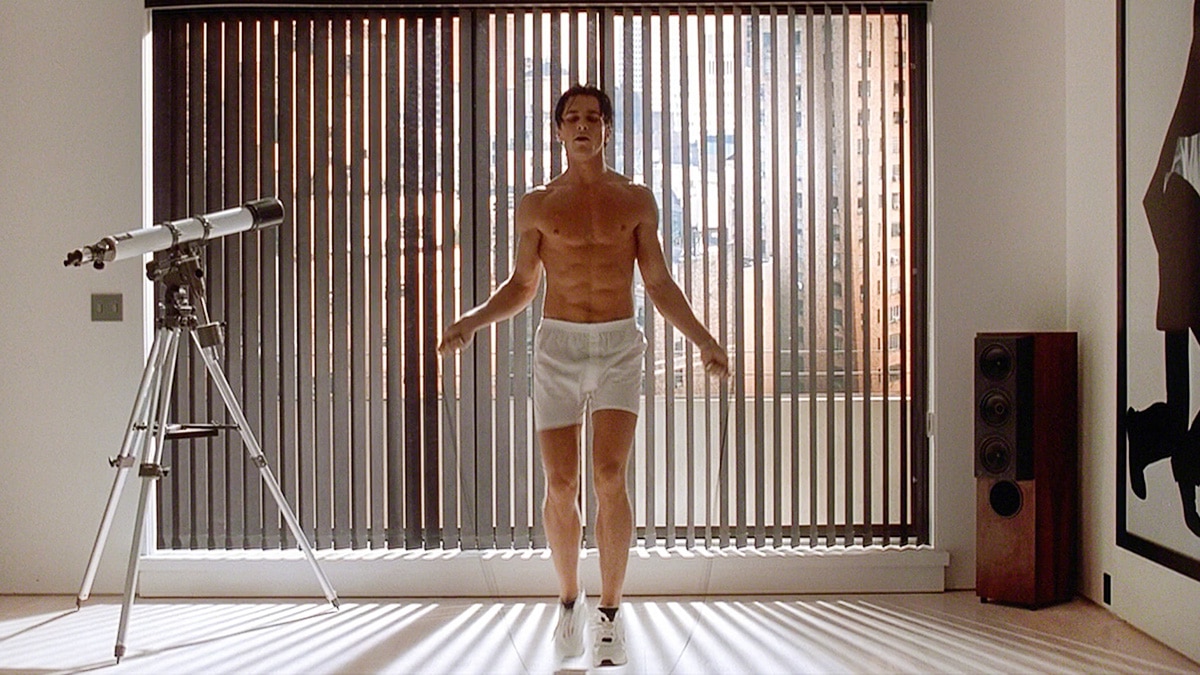
Similar to Brad Pitt, what makes Christian Bale look so remarkable here is that he’s impressively lean, at maybe 8–10% body fat. That’s a little bit leaner than the average person could comfortably maintain, but depending on your genetics, it might be realistic for you. Here’s an example of our one of our members accomplishing something similar:

What’s nice, though, is that Christian Bale is also famous for his role as Batman, where he has a significantly higher body-fat percentage. That physique is realistic for almost all of us. And unlike Brad Pitt, he doesn’t have genetically broad shoulders, a full chest, or a narrow waist. The average skinny guy with an ectomorph bone structure can expect to look like this, and to be healthy and happy at that body-fat percentage year-round. It’s a good physique to aim for. Again, of course, you won’t look exactly like him, but this degree of leanness and muscularity is probably realistic.
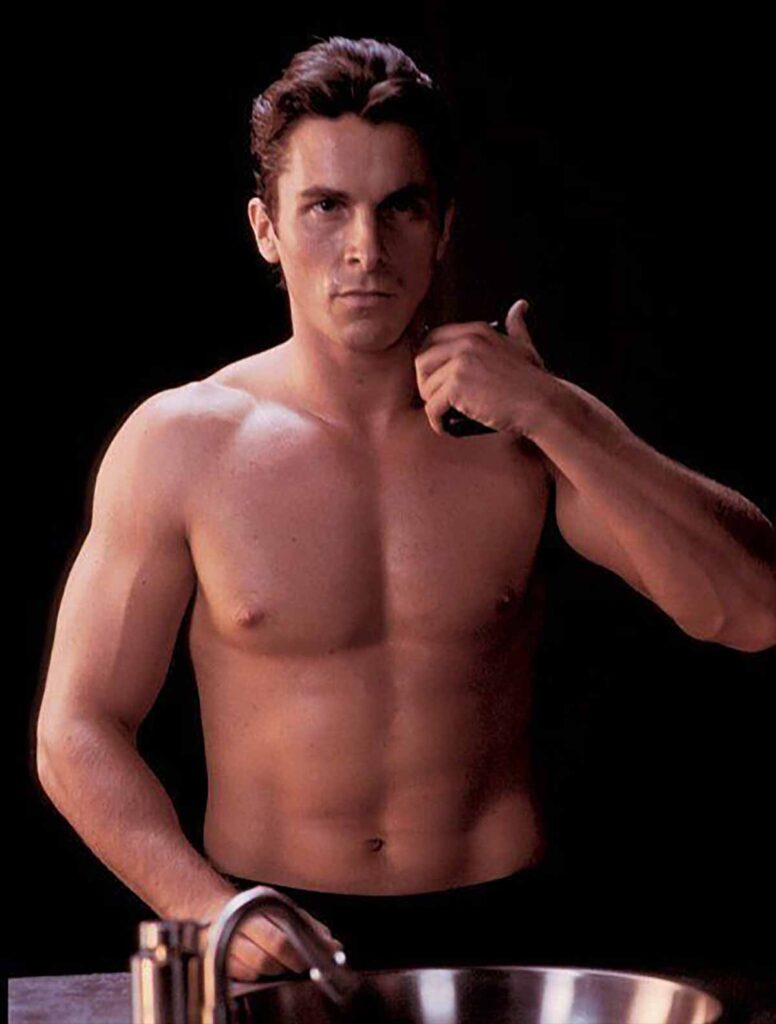
So, why do Christian Bale’s physiques look great? There’s no real magic here. He doesn’t just look fit and athletic, he also looks strong. He looks like he lifts weight. And he does.
How do you build this physique? Well, it doesn’t look like he spends much time squatting or deadlifting. His legs and traps aren’t all that muscular. They aren’t skinny, but not muscle-bound either. You can build a body like this by emphasizing the bench press, overhead press, chin-up, curl, and skull crusher, not so dissimilar from Brad Pitt. You should probably still front squat and deadlift, just for your general health and strength—and to help improve your posture—but those lifts have little to do with building this physique.
Daniel Craig in James Bond
Daniel Craig is the rare guy in this group who seems to have exceptional genetics. Not that he’s naturally muscular like Arnold Schwarzenegger or anything, just in the sense that even when he doesn’t exercise, he still seems to look naturally athletic. He only had to lift weights for 3 months to build the physique that made him famous in the Casino Royale movies.
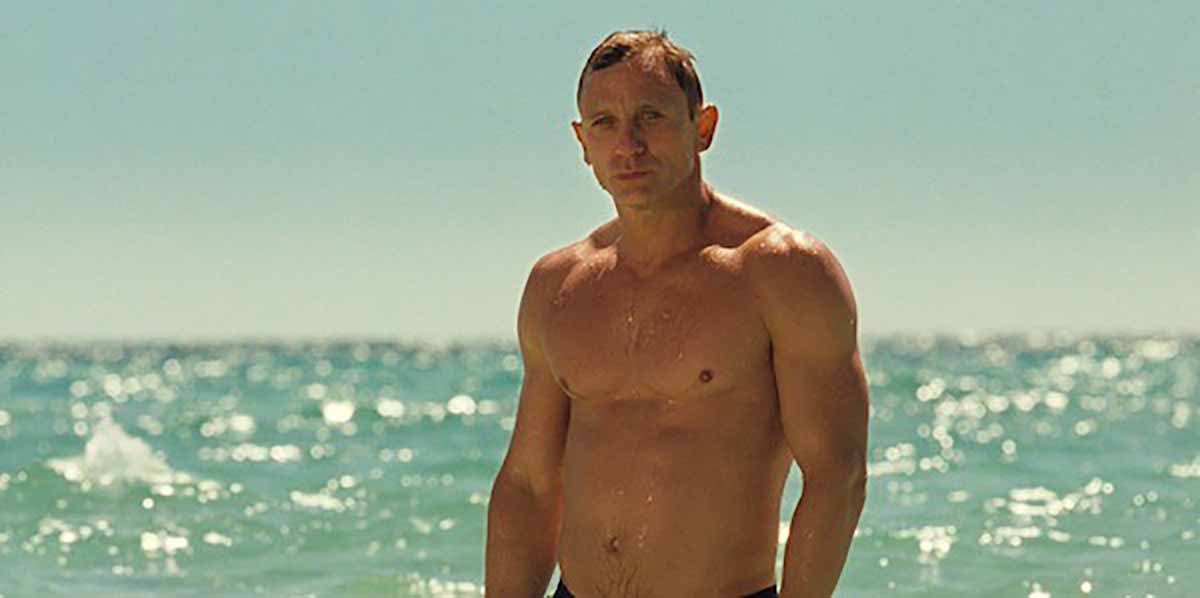
You can build a physique like that, too. This is well within virtually everyone’s genetic potential. It just might take you a bit longer than 3 months to get there. Or maybe not.
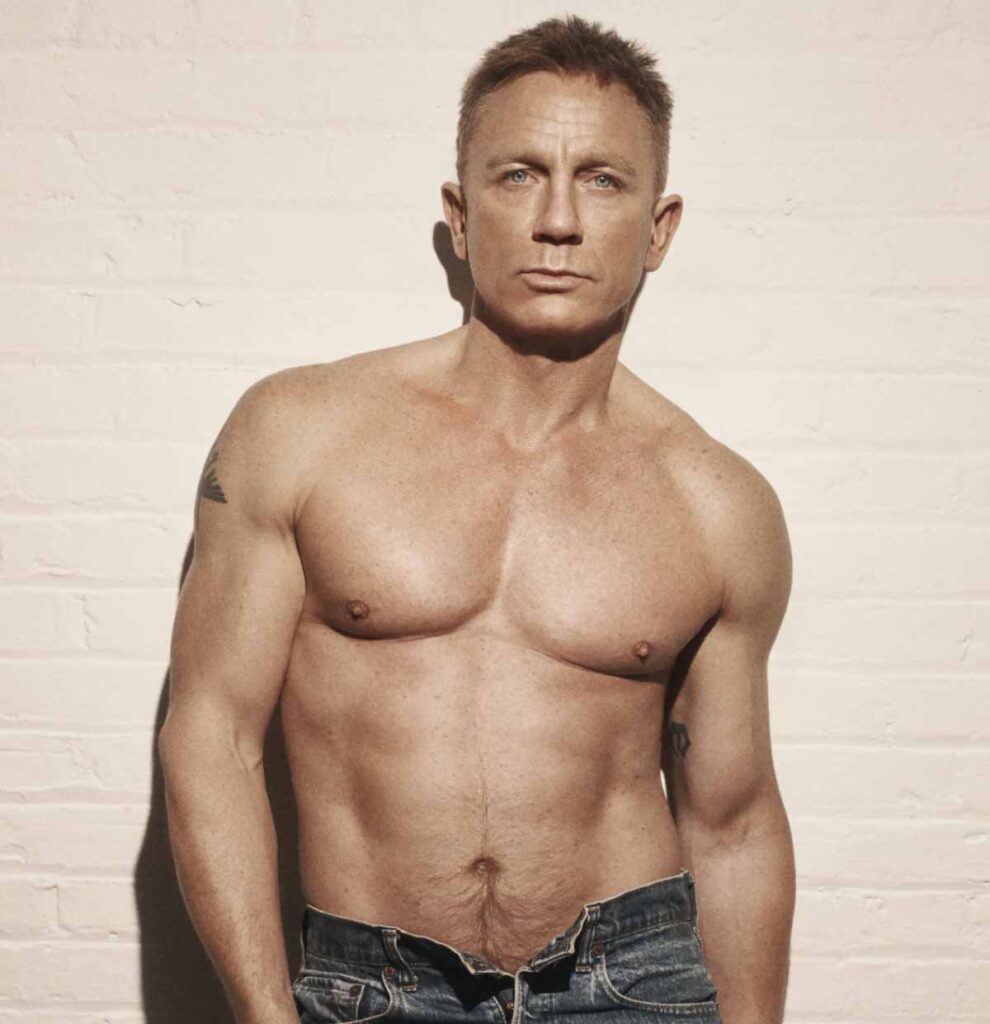
What’s especially cool, though, is that his physique has only continued getting better as he’s kept on training for his roles in James Bond. It seems that every time he gets in shape again, he’s able to build on his previous progress, even as he continues to grow older.
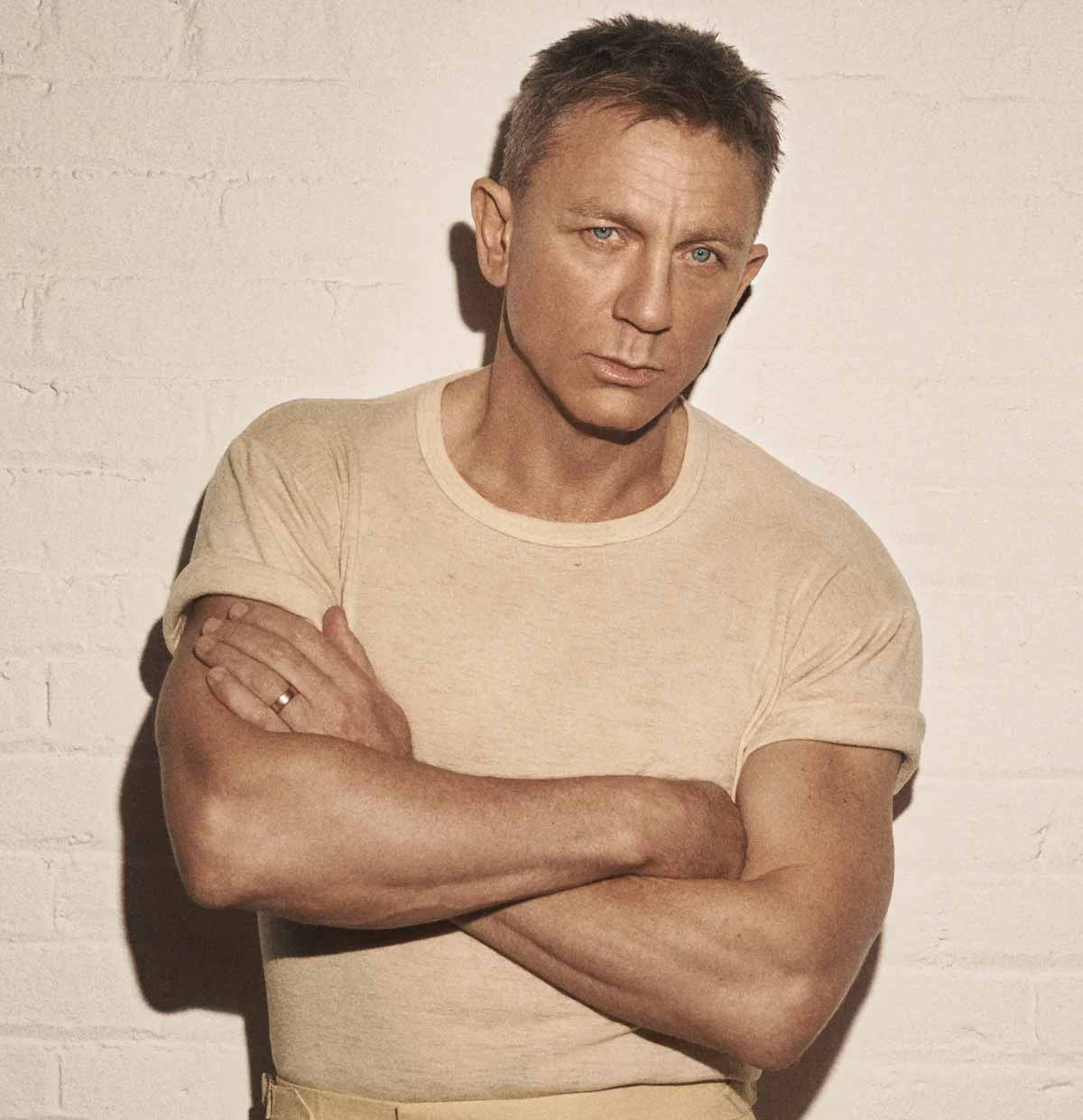
The other neat thing is that he’s clearly naturally slim. As soon as he puts a shirt on, he stops looking impressively strong and starts looking more fit. And that’s great. Not only is this a physique that naturally skinny guys can build, but it probably won’t even be very hard. I suspect you could build this physique and still be 30 pounds away from your genetic muscular potential.
What makes this body look so good, I think, is that it looks quite well-rounded. He doesn’t just have a big chest, he also has big shoulders and traps, and his back looks great. This is the kind of physique you can build with the bench press, overhead press, and chin-up. Especially in that Casino Royale photo, that’s an overhead press physique—strong through the shoulder girdle. As with most of these transformations, his legs aren’t a strong point, and they’re rarely even shown.
Will Smith in I Am Legend
What I love about Will Smith is that he got famous on the Fresh Prince of Bel-Air, starting off as a young skinny guy. But it seems like he’s good at routinely exercising, and his habit of lifting soon saw him building quite a bit of muscle.

Fast forward a few years, and Will Smith is starring in action movies. My favourite version of that is in I Am Legend, but Will Smith is always in great shape, so almost all of his roles show him with a great physique. I don’t know what his lifestyle is actually like, but it seems like he’s a guy who just habitually exercises, eats a good diet, and always looks good.
When we see him in movies, he isn’t at 10% body fat or anything crazy, either. In those photos, I’d guess he’s more like 13–15%, which is a comfortable, healthy body-fat percentage for almost everyone. Is his physique as famous as Brad Pitt’s in Fight Club? Maybe not. But he looks quite a bit stronger, and his body-fat percentage looks quite a bit more athletic and healthy. If you want something aspirational to aim for as a longer-term goal, I’d say this is a great place to look.
Now, the bad news is that in that second photo, on the right, Will Smith actually looks pretty damn strong! No surprise, since it seems like he’s been lifting for decades now. I looked around online, and it’s always hard to know what to trust, but it seems like he can bench press over 315 pounds. That’s at the upper limit of what you might expect to bench as a naturally skinny. You may never get quite as strong as Will Smith, but you’ll probably be able to get close.
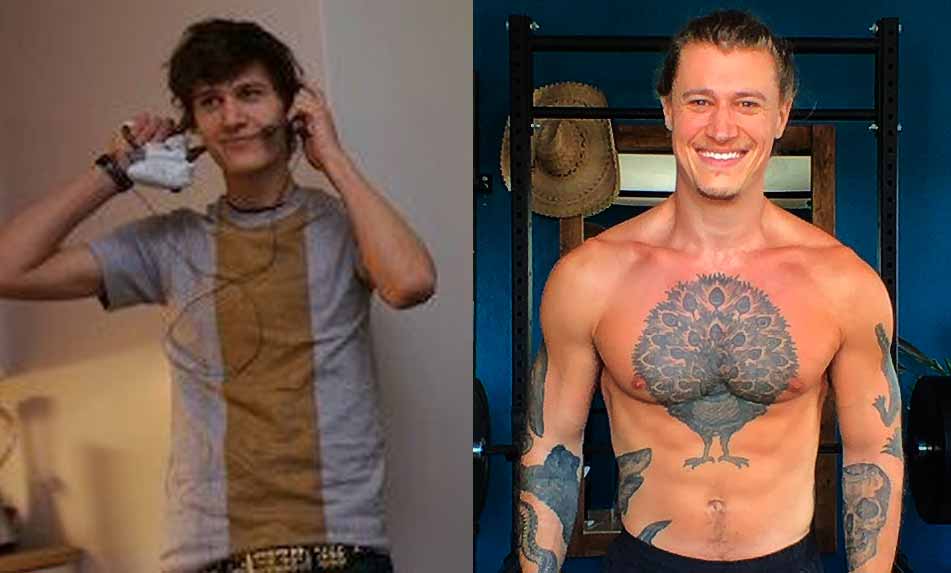
Here’s my own transformation. I’m not as big or strong as Will Smith in his prime, but I feel like I’m in striking distance of it, and it motivates me to continue outlifting myself, getting ever stronger. Will I ever bench 365 or however much he can bench? Maybe not. I’m fighting for 315 right now, hoping for it by the end of the year. But it’s inspiring even if most of us can’t quite get there.
On the bright side, you could probably build a physique that looks comparably badass simply by training the muscles that Will Smith doesn’t—his neck muscles. I think that’s one of they key reasons why Brad Pitt looked so cool despite being way smaller.
How to Build a Hollywood Physique
There are a few trends with these physiques. Most of them have great chests, which is why they look so good shirtless. It’s common to see well-developed arms, too. And it seems like the actors with well-developed traps and necks look especially good. That makes me think that the best lifts for building an action hero, sex-icon physique are the bench press for the chest, the overhead press for the shoulders and traps, the chin-up for the upper back and arms (and abs), the biceps curl for the biceps, and the skullcrusher for the triceps. And then for bonus points, add in some neck curls and extensions to bulk up your neck.

Some squats and deadlifts would probably help, too (and Hugh Jackman famously used them for his role as Wolverine). But to be honest, none of these actors seem to spend much time developing their lower bodies, and so their legs aren’t really a factor here. That makes sense. Our quads and glutes are the two biggest muscles in our bodies, but they don’t seem to be a significantly impact our attractiveness or aesthetics (study).

With that said, front squats and conventional deadlifts aren’t just great for building bigger legs, they’re also great for building the spinal erectors and improving posture. And the conventional deadlift is great for the traps, too. A lot of famous Hollywood physiques have great traps, including both Brad Pitt and Daniel Craig.

If you want to build this style of physique, I’d recommend training your entire body with the big compound lifts, including the squat and deadlift along with the bench press, overhead press, chin-up, and row. That will add size to your entire body in a fairly balanced way. But don’t stop there. Add in extra isolation lifts for your target areas: biceps curls, triceps extensions, shoulder raises, neck curls, neck extensions, and maybe some crunches or hanging leg raises for your abs. That way your entire body will have a good foundation of strength, and your lower body won’t look weak or disjointed, but your upper body muscles will have some extra mass.
The main thing to keep in mind is that when training for muscle size, you should train specifically for muscle size. The biggest mistake we see is guys who do programs like Starting Strength or StrongLifts 5×5, which are fine programs, but they’re squat-dominant strength training programs that are designed to make people better at powerlifting. They aren’t that great for building muscle, especially in the way that these celebrities often do it, where the emphasis is on the shoulder girdle, not on the thighs and hips.
So the first thing to focus on is training in a way that’s designed to stimulate muscle growth. Bodyweight workouts can be effective, resistance bands can work in a pinch, and strength training usually stimulates some muscle growth, but the best way to build muscle is to train for muscle growth—hypertrophy training.
Hypertrophy training is designed for muscle growth, and so a good hypertrophy program simply follows the evidence. If a certain method builds more muscle, it’s built into the hypertrophy routine. For instance:
- Big compound lifts for your bigger muscles, such as your chest, upper back, butt, and shoulders. Think of the squat, bench press, deadlift, overhead press, chin-up, and row. Keep in mind that you should choose your lifts based on what builds muscle, not on the powerlifting or Olympic lifts. And if you’re a beginner, start with beginner lifts.
- Isolation lifts for the smaller muscles, such as biceps curls for your biceps, skullcrushers for your triceps, curls and extensions for your neck, and perhaps some crunches or planks for your abs.
- Long enough rest periods that we’re limited by our muscles more than our cardiovascular systems. Resting 2–5 minutes between sets often works well. (And then you can do cardio on the side, if you want. It’s great for your health, but it won’t have much impact on your appearance.)
- Lifting close enough to failure to truly challenge your muscles, provoking muscle growth. That often means taking some sets to failure so that you learn what failure feels like, and so that you see how far away from it you’ve been stopping.
- Doing enough challenging sets per muscle, per workout, and per week. An easy way to do that, especially as a beginner, is to do 3 full-body workouts per week, doing a few sets for each major muscle group every workout. Then, as you get more advanced, you can divide up your training over more days if you want to (although I’ve gained 65 pounds without ever needing to).
- Do most of your lifting in the so-called “hypertrophy rep range,” somewhere between 6–20 reps per set. That might mean 6–10 reps for your bigger compound lifts, such as squats and deadlifts, 8–15 reps for your secondary lifts, such as biceps curls and triceps extensions, and 12–20 reps for smaller lifts, such as neck curls and lateral raises.
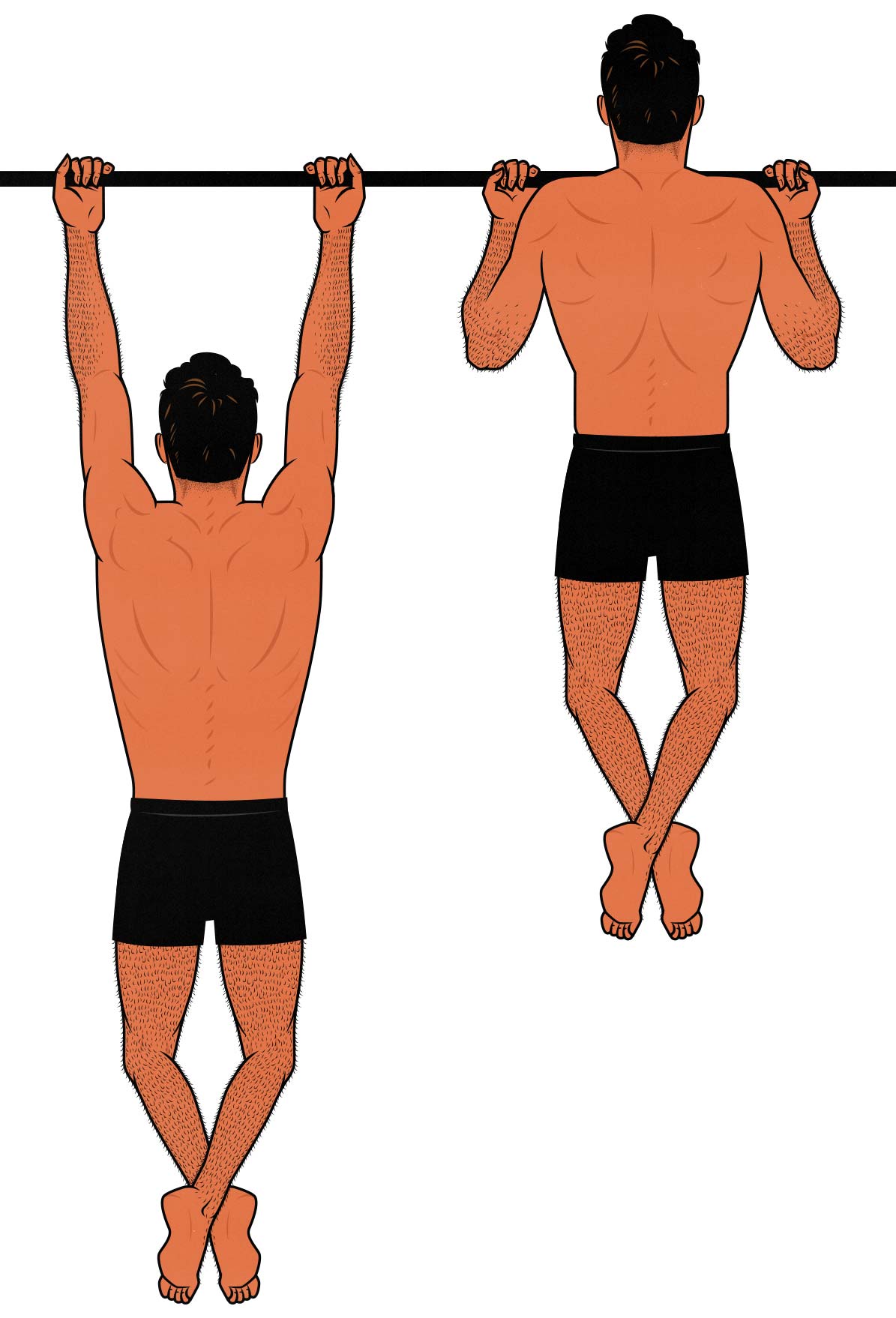
And then along with your hypertrophy training, make sure that you’re eating enough protein to build muscle (0.8–1 gram per pound bodyweight per day), that you’re eating enough calories to gain weight (about 500 more calories than you currently eat), and that you’re getting enough good sleep every night.
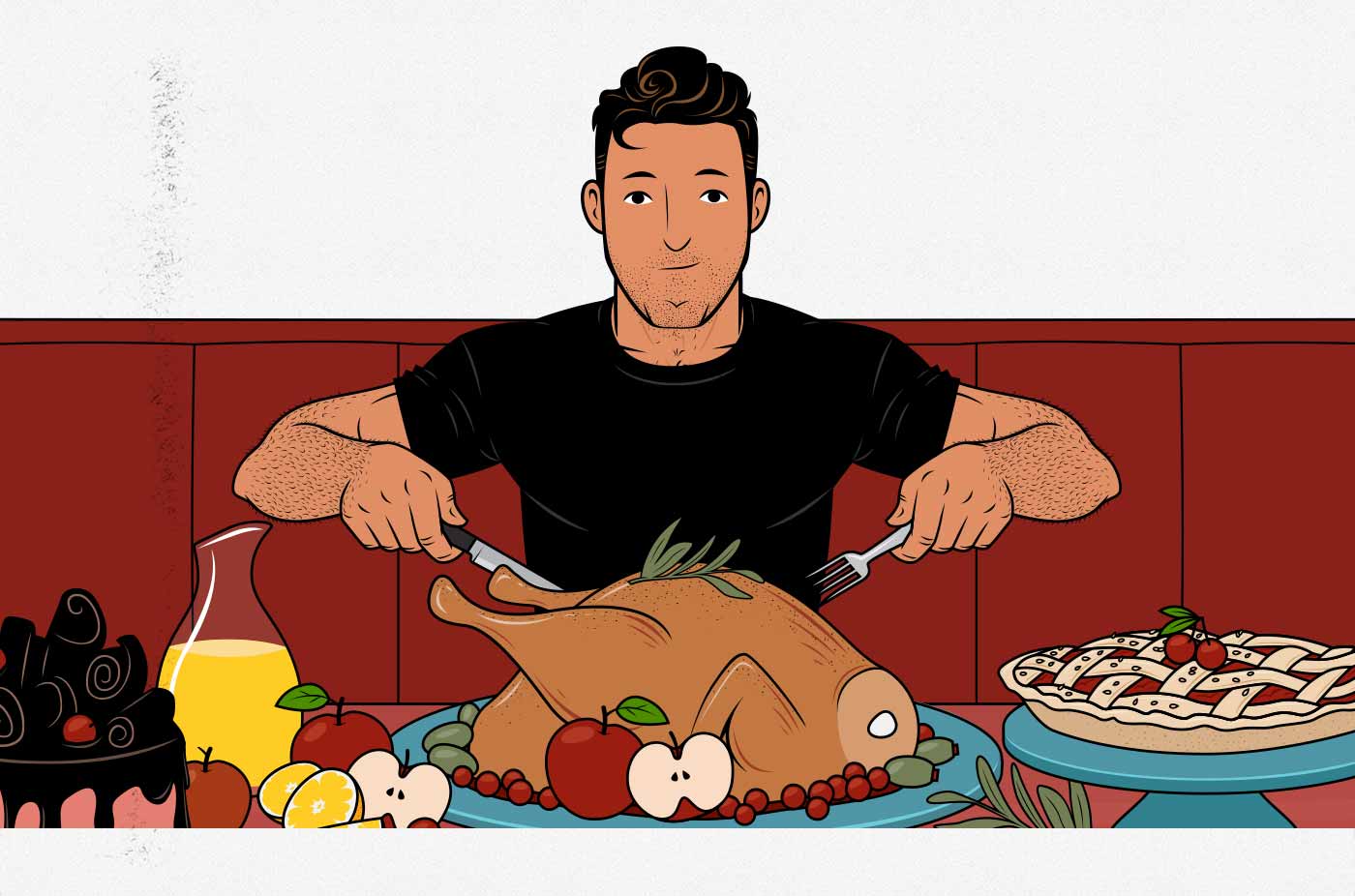
If you want a program that puts all of this together—a 5-month workout routine, video tutorials teaching all of the lifts, a full diet guide, a recipe book, and a yearlong membership in our coaching community—I think you’d like our Bony to Beastly Program.
Whatever program you use, though, keep in mind how these actors make these amazing transformations. I’ve seen some of the workout programs they used, and they aren’t always very good. But actors are notoriously good at putting in the work, lifting hard, and sticking to their diets. The main thing is getting started, being consistent, always striving to outlift yourself, and pivoting whenever you run up against a setback.
Shane Duquette is the founder of Outlift, Bony to Beastly, and Bony to Bombshell, each with millions of readers. He's a Certified Conditioning Coach (CCC), has gained 70 pounds, and has over a decade of experience helping more than 15,000 people build muscle. He also has a degree in fine arts, but those are inversely correlated with muscle growth.
